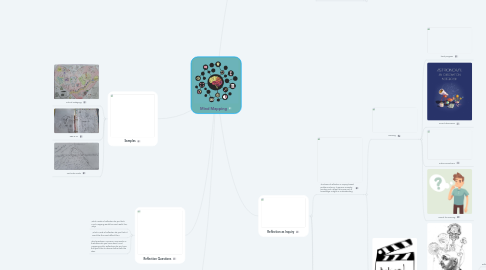
1. Create
1.1. How to Make a Mind Map - The Basics
1.2. Central Idea
1.2.1. Branch out
1.3. Key Words
1.3.1. Color
1.3.1.1. Images
2. Samples
2.1. Critical Pedagogy
2.2. EBD & ID
2.3. Test Note Cards
3. Reflection as Inquiry
3.1. The basis of reflection is inquiry-based problem-solving. It requires curiosity, scrutiny and a quest for some sort of knowledge, insight or understanding.
3.1.1. Learning
3.1.1.1. track progress
3.1.1.2. record discoveries
3.1.1.3. make connections
3.1.1.4. search for meaning
3.1.2. Action
3.1.2.1. Reflection is an invisible process that goes on inside our heads constantly. If this reflection is deep enough, it gives us lasting insights or knowledge—what we call experience, something we can call up subsequently to help guide our responses.
3.1.2.1.1. Reflection informs Action
3.2. Identity
3.2.1. Who am I
3.2.2. What is my place in this world
3.3. Modes of Reflection
4. Reflection Questions
4.1. Which mode of reflection do you think Mind Mapping would be most useful for? Why?
4.2. Which Mode of reflection do you think it would be the most difficult for?
4.3. What questions, concerns, comments, or frustrations do you have about Mind Mapping and/or Reflections do you have that you'd like to discuss further with the class.
5. Reflection Activity
5.1. Watch any crash course theatre video you want. This must be decided in class to avoid repeats. Once one of your peers declares the one, they are doing, it cannot be used. After watching it, create a mind map based on the video. We will be presenting the mind maps in class Tuesday, 9/7.
5.1.1. Requirements
5.1.1.1. It must be colorful
5.1.1.2. Include lots of images. Remember theatre is a visual medium.
5.1.1.3. It must be reflective
5.1.1.4. You can complete this digitally or by hand.
5.1.1.5. You will be presenting this to the class
